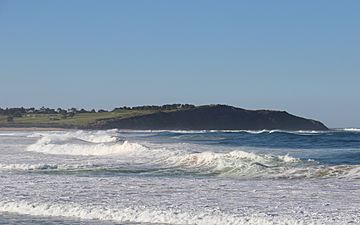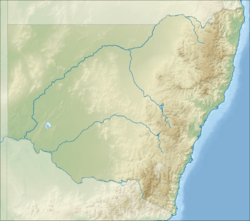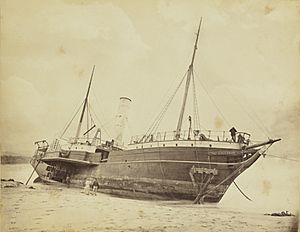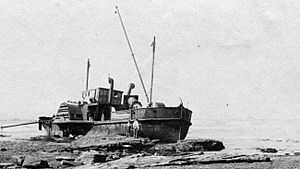Long Reef (New South Wales) facts for kids
Quick facts for kids Long Reef (New South Wales) |
|
|---|---|

Long Reef photographed from Dee Why
|
|
| Highest point | |
| Elevation | 45 m (148 ft) AHD |
| Geography | |
| Location | Collaroy, New South Wales, Australia |
| Geology | |
| Age of rock | Triassic |
Long Reef is a large piece of land that sticks out into the ocean. It is located in the Northern Beaches area of Sydney, Australia. A narrow strip of land, called a tombolo, connects it to the mainland. The reef also has a wide, flat rock area called a wave-cut platform, which was shaped by ocean waves.
Long Reef is a popular spot for fun activities. It is also one of the most interesting places in Sydney to learn about rocks and how the Earth was formed.
Contents
Discovering Long Reef's Ancient Rocks
Long Reef is home to some of the oldest rocks in the Sydney area. Most of these rocks formed during the Triassic period, which was about 252 to 201 million years ago. They belong to a group of sedimentary rocks called the Narrabeen Group. Sedimentary rocks are made from layers of sand, mud, and tiny bits of plants and animals that build up over time.
The tall cliffs at Long Reef are made of a rock called Bald Hill Claystone on top, with Bulgo Sandstone underneath. There was once a volcanic dyke here, which is like a wall of rock that formed when hot, melted rock (magma) pushed up through cracks in older rocks. This dyke was made of dolerite and was about 60 centimeters wide and two meters tall. It formed during the Jurassic period. However, much of it has been removed by mining.
The most common rock in Sydney, Hawkesbury sandstone, is not found at Long Reef. It appears a short distance south at Dee Why headland. A fault (a crack in the Earth's crust where rocks have moved) under Dee Why beach separates these areas.
In the 1880s, people mined for copper at Long Reef. They dug a tunnel on the southern side of the headland. The beach below the cliffs has layers of shells and dark minerals. These beach sands contain minerals like Ilmenite, rutile, zircon, and monazite. The cliffs also show signs of ironstone and laterite, with fallen rocks of haematite, which is rich in iron. Small freshwater springs flow from the cliff face, caused by water trapped underground. You can also see evidence of faults (cracks) and folding (bends) in the rocks at Long Reef.
Ancient Life: Fossils at Long Reef
On the southern side of Long Reef, you can find many grey claystone rocks that have fallen from the cliffs. These rocks often hold fossils of ancient plants. The most common plant fossil found here is the horsetail, called Phyllotheca. Sometimes, you might also find fossils of a shrub-like plant called a seed fern (Dicroidium).
In 1986, scientists found part of a fossilized jawbone (mandible) from a giant amphibian at Long Reef. This fossil was found in the Bulgo sandstone. Scientists believe the complete jawbone would have been about 1 meter long! This ancient amphibian, called a temnospondyl, lived during the Triassic period. It was named Bulgosuchus gargantua and is only known from Long Reef.
The forests that grew here during the Triassic period were "oligotrophic," meaning the soil had very few nutrients.
Long Reef's Human Story
The first people to live in the Long Reef area were the indigenous Australians, specifically the Kuringgai people of the Eora nation. Sadly, when European settlers arrived in the late 1700s and early 1800s, the Aboriginal population was greatly reduced. We do not know their original name for this special place.
The first Europeans to visit the area were Governor Arthur Phillip and his team. They explored the coast north to Broken Bay on August 22, 1788. The name "Long Reef" was being used by 1814.
In 1815, a shipbuilder named William Cossar was given 500 acres (about 202 hectares) of land at Long Reef. By 1825, a farm with 52 cleared acres at Long Reef was put up for sale. One old fisherman's hut from the 1870s still stands at Long Reef today. The Salvation Army owned Long Reef from 1900 to 1912.
Shipwrecks and Sea Stories
Even though Long Reef is a noticeable headland, no lighthouse was ever built here. Because of this, many ships have had accidents or sunk near Long Reef.
Some famous ship incidents include:
- The Windsor sank in 1816.
- The Greyhound sank in 1904.
- The steamer Duckenfield sank in 1889.
- The Sylphide, a large sailing ship, sank off Long Reef in 1877.
In the 1970s and 1980s, many ships were purposely sunk off Long Reef. This was done to create "artificial reefs," which are underwater structures that provide homes for marine life. Some of these ships were old Manly ferries, like the Dee Why and Bellubera. Other vessels included the 50-meter-long bucket-dredge Coolooli, the tugboats Meggol and Himma, and HMAS Doomba. The Australian National Shipwreck Database lists 25 shipwrecks and intentional sinkings connected to Long Reef.
The Stranded SS Collaroy
In 1881, the paddle steamer SS Collaroy was sailing from Newcastle to Sydney. It got lost in a thick fog and ended up stuck on the beach near Long Reef. The ship's mate and captain lost their licenses for three months because of the accident.
The ship stayed stranded for three years! This shipwreck gave its name to the nearby Sydney suburb of Collaroy. Eventually, the ship was freed and put back into service. However, it was wrecked again in July 1889 at Eureka Point, California.
The Myola Shipwreck
The SS Myola was a 655-ton steamship, 55 meters long, built in England. On April 1, 1919, the Myola left Newcastle heading for Sydney with 675 tons of coal. Off Long Reef, a huge wave hit the ship, and the collier (a ship that carries coal) sank. Another steamer, the South Bulli, was four miles behind and saw distress flares. It helped rescue survivors, but sadly, four lives were lost.
The wreck of the Myola was found off Long Reef in 1994. It lies 48 meters underwater, resting on its left side.
The Euroka Incident
In 1913, the 170-ton iron paddle steamer SS Euroka was traveling south with coal from Lake Macquarie. On its way to Sydney, the steamer ran aground (hit the bottom) several times. The ship started taking on water, and Captain Benton decided to abandon the ship at 5 PM on October 19, 1913.
Eventually, the Euroka ran aground in five meters of water at Long Reef. Luckily, no lives were lost. The wreck of the Euroka was sold for £155. Parts of the ship were removed and sold. The rest of the vessel was left behind and broke apart over a wide area. In May 1915, a salvage crew diving on the wreck found another ship, the Susannah Cuthbert. This coal ship had run aground on the reef on July 7, 1875.
Fun Activities and Facilities
Long Reef offers many ways to have fun! Popular activities include walking, surfing, swimming, fishing, and snorkeling. You can also try wind surfing, aeromodelling (flying model aircraft), and hang-gliding. Exploring the flat rock platform at low tide is also a favorite activity.
Thousands of school students have visited Long Reef for school trips. The Long Reef Golf Club was started in 1921. For visitors, there's a viewing platform, public toilets, showers, picnic areas, electric barbecues, and a small shop. Finding free parking can be tricky on busy days.
Scuba Diving and Marine Life
Scuba diving is popular at a spot called "the wall," which is a 200-meter-long underwater structure. At "the cathedral," two sloping rocks form an open cave that looks like a church. "The apartments" are stacked horizontal rocks that divers can swim through.
"The wall" is home to many types of fish, including bull rays, blue devils, snapper, yellowtail kingfish, blue groper, Port Jackson sharks, red morwong, wobbegong, large cuttlefish, and the rare grey nurse shark. You can also often see large groups of small fish, such as pomfret, yellowtails, and bullseyes.
Amazing Birds and Sea Creatures
Long Reef is a very important place for many types of migratory shorebirds. These are birds that travel long distances. Some seabirds not often seen in Sydney that visit Long Reef include the Ruddy turnstone, Bar-tailed godwit, Grey-tailed tattler, Red-necked stint, Black-browed albatross, Little penguin, Sooty oystercatcher, Osprey, Antarctic prion, Red-tailed tropicbird, Double-banded plover, and the Pacific golden plover.
Many different invertebrates (animals without backbones) live on the reef. You can spot some of them at low tide. These include sea anemones, barnacles, limpets, chitons, gastropods (like snails), including cowrys, blue-ringed octopus, nudibranchs (sea slugs), crabs, sea stars, sea urchins, marine worms, cockles, oysters, sea sponges, tube worms, and cunjevoi. Divers can also see Weedy seadragons. Large areas of Neptune's necklace (a type of seaweed) grow on the reef.
Exploring Intertidal Rock Pools
The tide pools at Long Reef are home to many different living things. Neptune's necklace (Hormosira banksii) is very common in and around these pools. Sea grasses like Zostera capricorni also grow here.
Molluscs found in the pools include the pyramid periwinkle, black nerite, southern periwinkle, zebra top, limpet, false limpet, mulberry whelk, snakehead cowry, cart-wheel, striped-mouth conniwink, lightning turban, military turban, boat shell, blue angel (a type of sea slug), black-lip abalone, and various types of chiton. The blue-ringed octopus is a dangerous resident of these rock pools. Sometimes, the gloomy octopus can be found in larger pools. The banded periwinkle might be seen in the splash zone in rock cracks above the pools. Another mollusc found here is Thylacodes sipho, known as a "worm shell."
The waratah anemone and green snake lock are common sea anemones. Others include the white-striped anemone and the red anemone.
Sea urchins found here include the pink sea urchin, Heliocidaris erythrogramma, and Heliocidaris erythrogramma. Sea stars include the carpet sea star, velvet sea star, brittle star, and the dwarf cushion star.
Galeolaria caespitosa is a common tube worm, sometimes called "Sydney coral." Crabs include decorator crabs, hermit crabs, and the purple rock crab. Barnacles in the inter-tidal zone include the rose barnacle and six sided barnacle.
Fish can sometimes get trapped in the rock pools at low tide. Examples include the smooth toadfish (Tetractenos glaber), young mullet, and goby (Favonigobius lateralis).
Plants and Animals of Long Reef
Themeda grassland used to be very common at Long Reef. In recent years, people have worked to bring it back in some areas. There are also areas of heathland and shrubland with plants like coast tea tree, coast rosemary, and coast banksia. An invasive species here is bitou bush. The grassy area at Long Reef is officially a "Threatened Ecological Community." Local groups are working to remove invasive weeds and help native plants and animals thrive.
Some wild animals like feral foxes and rabbits have been seen here. Native animals living at Long Reef include the jacky lizard, blue tongue lizard, bandicoot, and ring tail possum. Between 1998 and 2004, young green and gold bell frogs were released into special ponds on the Long Reef Golf Course. However, this effort has not been very successful. Other types of frogs do live at Long Reef, such as the striped marsh frog, eastern froglet, dwarf tree frog, and the emerald-spotted tree frog.
Images for kids









